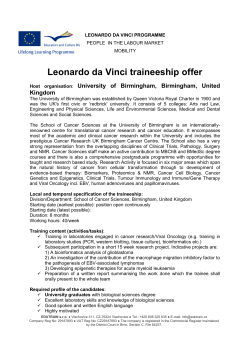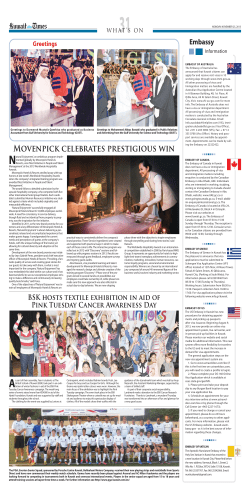
Bratislava region: Towards a RIS3 strategy Strasbourg, 4 December 2012 Dr. Štefan Vrátny
Bratislava region: Towards a RIS3 strategy Strasbourg, 4 December 2012 Dr. Štefan Vrátny Mgr. Peter Furik Martin Hakel Innovation strategies on the state and lands level – present situation • State level: No complex National innovation strategy was developed in 20 years of existence of the Slovak Republic so far • Lands level: all lands have carried out the RIS 2, but due to low competencies of the land government’s insufficient implementation • Insufficient support of SMEs, tax and insurance increase , unemployment of 14 % / 32 % young people, low R&D expenditures of 0.49 % / 0.68 % incl. SF expenditures • Results: Innovation scoreboard 22/27, FP7 participation 22/27, unemployment 22/27 • Challenge to change: Central government systematic intervention is necessary Preconditions of Innovation strategy development and implementation • GDP growth cased by FDI - the automotive industry development (VW, PSA and KIA and their supply chain) and by the electro technical industry, much less by domestic SMEs • Systematic SME support in access to finance, to market, to qualified working force necessary • Support of research universities, SAS, emphasis on applied, “problem solving” research related to SK and EU industry needs • Structural Funds inflow OPs education, infrastructure, SMEs, R&D, – but very low SF administration efficiency EC support needed • SF forms main part of R&D financing • Smart Specialization Strategy – priority definition related to limited R&D and Innovation expenditures on national and regional level RIS 3 BSK • BSK is a developed region, but certainly less than stated by the Eurostat • High concentration of companies and financial institutions, full employment • VW Slovakia, investments in hi-tech, e.g. e-car manufacturing, impact of supply chain companies • Concentration of ICT companies – IBM, Siemens, HP and others • Dynamic development of Slovak R&D ICT companies, e.g. ESET, Sygic, Ardaco, Sitel • Operation of energetic companies Concentration of Slovak R&D base in Bratislava • 53% of national R&D staff • 62% of FP7 financial means run in Bratislava (20% in Košice) • 70%+ scientific publications and quotations and 50%+ new knowledge and technology generation • Critical mass on basic and applied research in main SS domains • Related to regional and international industry, e.g. automotive • Creation of modern R&D infrastructure financed form SF, but • Low financing of R&D activities: 1.2% of the GDP • Low wages of R&D staff especially young researchers (much less than in Brno or Vienna) • Insufficient national R&D financing “substituted” by SF Expectations from the Peer-Review Workshop Please define your objectives and expectations for the Peer Review Workshop: - To obtain an outside assessment of the RIS 3 in Bratislava region - To benchmark and to network the RIS3 Bratislava with RIS 3 from other regions of old and new MS Which issues would you like to discuss and why? - The possibility to develop support programmes for innovative SMEs - How to increase the R&D budget - Stimuli development for technology start ups and allocation of innovative SMEs - Possibilities of partially R&D activities realocation of MNC acting in the region to Bratislava (BA) - Structural funds flexi rules for R&D &I in BA region Introduction of Your Region’s work on Research and Innovation Strategy • The regional innovation strategy is being elaborated as the „ex ante“ structural funds (SF) for R&D&I and in order to concentrated scared financial resources for R&D&I processes • Strategic vision: Creation of a R&D&I region of European meaning Place-based dimension of the RIS3 – Main competitive advantages: Research on construction materials, security and navigation software and cancer diseases diagnostics methods – Key challenges: Improved R&D infrastructure, dedicated R&D staff, European / world results in selected domains • Please describe the main steps of the process your region went through to identify the above elements. You might give an overview and elaborate on the following slides covering possible steps in the process. – Analysis of FP 7 results, SF in R&D infrastructure, co-operation with industry, patents, PhD students, publications, commercialised R&D results in EU 15 and USA, Asia • How can your region use innovation to address the challenges? – Transition to knowledge driven economy, sustainable growth, job creation, society digitalization Looking beyond Your Region’s boundaries • Does region’s RIS3 take into account the external context, national/international? How? – RIS 3 has positioned the BA region within Slovakia regions but also within the Czech republic and Austria – neighbouring Vienna and Brno region – The comparative analysis methods have been used • External knowledge is of vital importance for the RIS 3 BA development and implementation – The BA region is considering especially the border regions RIS 3, e.g. the „JIC Brno“ implementation Entrepreneurial dynamics • Assessing entrepreneurial dynamics in Region: – Dynamic development of automotive industry (VW and PSA) and IT companies is typical for the BA region – Are the potentials for entrepreneurial discovery being detected? How? How are they linked to priority setting? – The construction materials (light metals and polymers) research is important for the automotive industry, the IT development (security (Eset), navigation systems (Sygic), data recognition for manufacturing, transport and marketing processes, the biomolecular research for fast cancer diseases diagnostics • Involvement of entrepreneurial actors in Region: – The research and academic community is more active than the business community as they lack money – The large MNC as VW or Siemens are not enough interesting in RIS3 as they make research mostly in their headquarters – It seems to be necessary to negotiate with their headquarters – The innovative SMEs are more interested but they lack any support Governance • Who coordinates the RIS3 design process in your Region? – BSK together with the Ministry of Education and Science (Minedu) • Do you have some kind of a regional partnership? – BSK, Minedu, the City of Bratislava, the political consensus has been achieved • How are relevant actors identified, approached, included and engaged in the development of the strategy? – The relevant universities (STU and UK), the Slovak Academy of sciences (SAS), the Centre for scientific and technical information (CVTI) and other relevant players are involved and do design the RIS 3 BA as well • Does it include a ‘triple/quadruple helix’ collaboration? – Yes, but the industrial sector should be more intensive involved • Which governance mechanisms exist to facilitate an entrepreneurial process – The main facilitation of the entrepreneurial process is FDI stimulation, other support mechanisms are almost missing, there is no industrial and innovation policy implemented • How are RIS3 priorities identified and decisions taken? – Who is involved in this process and what criteria are used? – – 3 main priorities: Material, ICT and Biotech research The criteria have already been mentioned Priorities? • Linking to governance, how and why have your RIS3 priorities been chosen? – RIS 3 priorities: European / world excellence, industrial use / commercialisation of R&D results, needs of local / global industry • What are the main criteria used to identify priorities for investment? – Scientific excellence, (world) market absorption potential, sustainability • Are priorities based on the analysis of the region’s strengths and weaknesses? – Yes • Are flexibility mechanisms in place for resource allocation if priorities are eventually reinforced / discarded? – Yes, as the priorities are relative „wide“ and general defined Digital Growth Priorities? • Have you developed (or planning to) in your RIS3 an explicit strategic policy framework for digital growth? – No • Does (or will) it include budgeting and prioritisation of actions through a SWOT analysis consistent with Scoreboard of the Digital Agenda for Europe? – No • Have you carried out any of the following: An analysis of balancing support for demand and supply of information and communication technologies (ICT)? Assessment of needs to reinforce ICT capacity-building? Indicators to measure progress of interventions in the field of digital literacy, skills, e-inclusion, e-accessibility, and e-health which are aligned with existing relevant sectoral national or regional strategies? No Implementation and Budget • How are your priorities underpinned by concrete action plans and roadmaps? – The concrete action plans are being elaborated • What tools and budgets will your region use to implement its RIS3 strategy? – Does your region have the necessary tools and budgets to succeed with the implementation? • The main tool and budget will be the OP R&D and the Innovation roadmap for BA region – Do you include both financial and non-financial support services? • Yes, but the amount of SF is uncertain – a big concern for the RIS 3 implementation • Does the strategy and its implementation integrate and exploit the synergies between different policies and funding sources? – Yes, but state budget resources are rather limited • Are relevant stakeholders and partners involved in the implementation stage of RIS3? – Yes, but the industry involment should be stronger • Does your RIS3 stimulate private R&D+I investments? – The issue will be discussed with the SARIO agency (FDI agency) • Who is responsible for the implementation? – BSK and Minedu Measuring the progress • What mechanisms are planned for monitoring and evaluation of the strategy’s implementation? – Degree of actions implementation and outcome indicators • What outcome indicators do you use/plan to use to measure the success? – R&D expenses increase, commercial use of R&D results, number of innovative start ups, allocation of technology companies to BA, reallocation of R&D activities of MNC to BA • Do you foresee a review of the strategy based on your evaluation outcomes to weed out non-performing investments? – Yes Self-assessment REGIONAL CONTEXT GOVERNANCE SHARED VISION IDENTIFICATION OF PRIORITIES Regional assets review Regional global position 4 Entrepenurial dynamic 3 Management of the process 2 Involvement of the institutional ecology 2 Public Private Partnership 2 Goal setting MONITORING & EVALUATION 2,5 Scenario 2 Communication 3 Robustness of the specialised assets (competitive advantages) Uniqueness of the advantages POLICY MIX 2,5 3,5 3 Critical mass and emerging potential (financial and human capital) 3,5 Roadmap action plan and pilot projects 2,5 Support services financial and non-financial ones including for social 2,5 Supportive administration and regulatory framework 2 List of indicators 2 Identification of target groups 3 Continuous review process 2 R E Informal assessment 4 3 2 1 0 Source: Eurada Summary and next steps • What is needed (in the short and medium term) to develop a good RIS3 in your region? • • • • Clear leadership in implementation process Financial means Central government support EC SF Flexi regulations – What are your region’s main RIS3 challenges? • The RIS implementation leadership and financing of the defined actions – What advice and activities would be useful to facilitate this process? • Implementation process, actions definition, financial underpinning Summary and next steps (2) • What are your immediate plans and what support do you need for a smart specialisation strategy (RIS3)? – Finishing the action plan and the innovation road map – Financial implementation securing. Peer review • How aware and supportive are your politicians, the regional/national administrations, the business community in your region, your national government? – The awareness is not sufficient yet, but it is improving. Especially the national government incl. Ministry of finance and the business community have to be better aware Friendly questions for discussion: analysis and implementation (1) • What is the analysis of the root causes of your challenges/ barriers to exploit your opportunities in your S3 strategy? – – – • Does the analysis in the S3 strategy you presented above (slide 4) in a satisfactory way identify the real challenges and preconditions for exploitation of opportunities in your region? • Yes, but the business community should be more intensive involved What are the strengths and weaknesses of your current analysis? • Strengths: analysis of the R&D potential, weakness: consensus of the business community and with the Ministry of finance, leadership in implementation Where do you need help? • Here, within the defined weaknesses Who can implement your S3 strategy? Are they likely to do it? – – – – Describe the levels, institutions, actors, and networks/ partnerships involved in the development and implementation of the S3 strategy. What is your “roadmap” of implementation? • Not elaborated yet What are risks and potential shortcomings? • Leadership and financing, not knowing the structural funds availability Do you need help from critical friends in implementation? • Yes Friendly questions for discussion: analysis and implementation (2) • Why do you expect that your S3 strategy will work? – Explain the causal chains between the implementation of your S3 strategy and exploitation of your opportunities (with reference to the root cause analysis) • Not elaborated – What are the strengths and weaknesses of your current S3 strategy? • Financial underpinning and implementation leadership – Where do you need help? • Here Friendly questions for discussion Innovation needs (1) • What are your expectations from Smart Specialisation? – What are the major expected achievements and outcomes of S3 in terms of regional governance, your triple/quadruple helix/system of innovation, and the competitive position of your region in the global economy as compared to how it is now? How does it work? • Increase of the regional global competitiveness of the BA region • In which areas do you need new ideas, methods, operational models or know-how to get there? – To what extent do you have networks with regions in other countries which you consider relevant to your work on S3? • Neighbouring regions, developed regions in the EU Friendly questions for discussion Innovation needs (2) • Who would you like to work with to make these innovations? – Who are your equal regions, and relevant partners in future dialogues? • Vienna, Brno, Munich region – Who do you feel can benefit from your advice and ideas (based on your achievements and good practices)? • Central and regional government, R&D and business community – From which regions would you look for ideas or relevant advice? • Vienna, Munich, Stuttgart, Oxford, Stockholm, Helsinki, • Are you considering to build a formal/informal network with the regions present at this workshop for discussing other issues in the future? – How are you planning to do that? • Yes, if regional and central government agree
© Copyright 2025





















